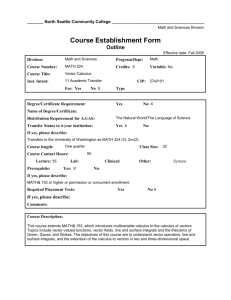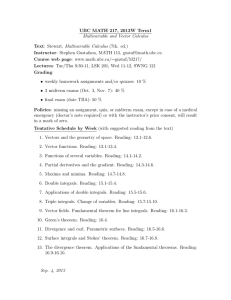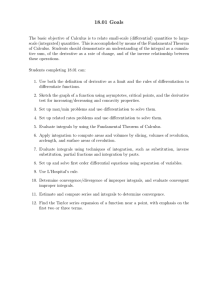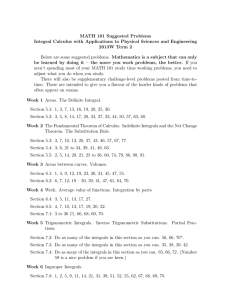Learning Goals
advertisement
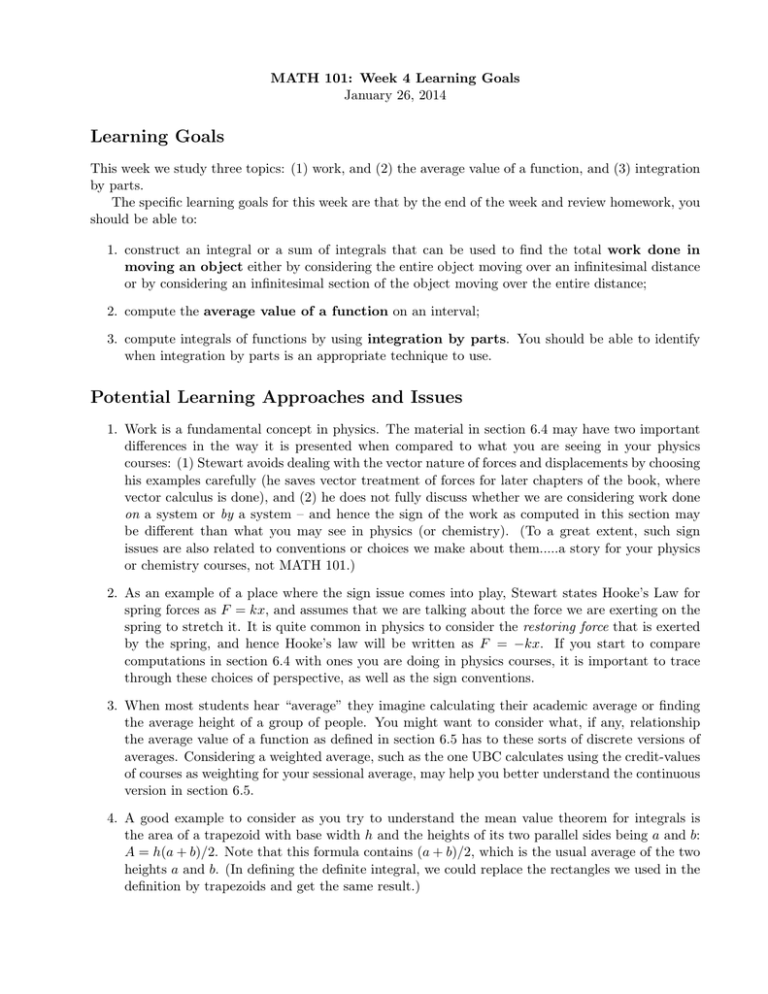
MATH 101: Week 4 Learning Goals January 26, 2014 Learning Goals This week we study three topics: (1) work, and (2) the average value of a function, and (3) integration by parts. The specific learning goals for this week are that by the end of the week and review homework, you should be able to: 1. construct an integral or a sum of integrals that can be used to find the total work done in moving an object either by considering the entire object moving over an infinitesimal distance or by considering an infinitesimal section of the object moving over the entire distance; 2. compute the average value of a function on an interval; 3. compute integrals of functions by using integration by parts. You should be able to identify when integration by parts is an appropriate technique to use. Potential Learning Approaches and Issues 1. Work is a fundamental concept in physics. The material in section 6.4 may have two important differences in the way it is presented when compared to what you are seeing in your physics courses: (1) Stewart avoids dealing with the vector nature of forces and displacements by choosing his examples carefully (he saves vector treatment of forces for later chapters of the book, where vector calculus is done), and (2) he does not fully discuss whether we are considering work done on a system or by a system – and hence the sign of the work as computed in this section may be different than what you may see in physics (or chemistry). (To a great extent, such sign issues are also related to conventions or choices we make about them.....a story for your physics or chemistry courses, not MATH 101.) 2. As an example of a place where the sign issue comes into play, Stewart states Hooke’s Law for spring forces as F = kx, and assumes that we are talking about the force we are exerting on the spring to stretch it. It is quite common in physics to consider the restoring force that is exerted by the spring, and hence Hooke’s law will be written as F = −kx. If you start to compare computations in section 6.4 with ones you are doing in physics courses, it is important to trace through these choices of perspective, as well as the sign conventions. 3. When most students hear “average” they imagine calculating their academic average or finding the average height of a group of people. You might want to consider what, if any, relationship the average value of a function as defined in section 6.5 has to these sorts of discrete versions of averages. Considering a weighted average, such as the one UBC calculates using the credit-values of courses as weighting for your sessional average, may help you better understand the continuous version in section 6.5. 4. A good example to consider as you try to understand the mean value theorem for integrals is the area of a trapezoid with base width h and the heights of its two parallel sides being a and b: A = h(a + b)/2. Note that this formula contains (a + b)/2, which is the usual average of the two heights a and b. (In defining the definite integral, we could replace the rectangles we used in the definition by trapezoids and get the same result.) 5. Integration by parts is an important idea. It is essentially a restatement of the fundamental theorem of calculus. It is worth looking at the formula for it to see if you can identify how this is so. As Stewart points out in section 7.1, this rule of integration is derived by considering the product rule. Suggested Problems Suggested Problems: Each week, I will post suggested problems on the main Math 101 website. These are in addition to the formal assignments you will do through WebWork. This week, all suggested problems will be from the text: Section 6.4: 3, 5, 11, 13, 17, 27. Section 6.5: 4, 7, 10, 13, 17, 19, 20, 22. Section 7.1: 3 to 36 (!), 66, 68, 69, 70.

